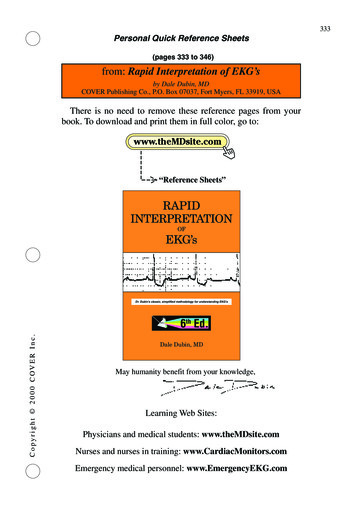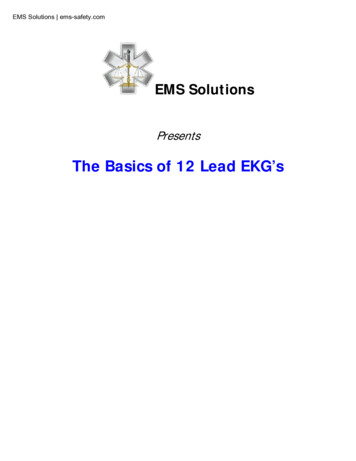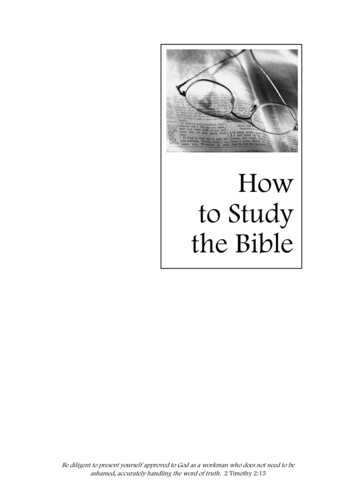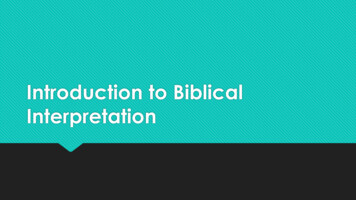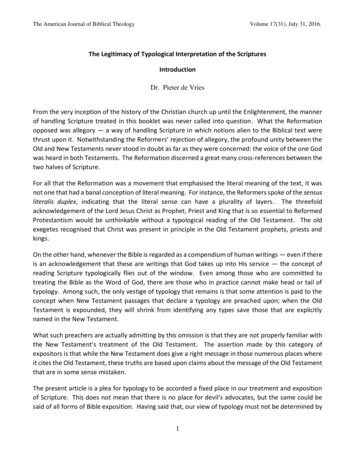
Transcription
The American Journal of Biblical TheologyVolume 17(31), July 31, 2016.The Legitimacy of Typological Interpretation of the ScripturesIntroductionDr. Pieter de VriesFrom the very inception of the history of the Christian church up until the Enlightenment, the mannerof handling Scripture treated in this booklet was never called into question. What the Reformationopposed was allegory — a way of handling Scripture in which notions alien to the Biblical text werethrust upon it. Notwithstanding the Reformers’ rejection of allegory, the profound unity between theOld and New Testaments never stood in doubt as far as they were concerned: the voice of the one Godwas heard in both Testaments. The Reformation discerned a great many cross-references between thetwo halves of Scripture.For all that the Reformation was a movement that emphasised the literal meaning of the text, it wasnot one that had a banal conception of literal meaning. For instance, the Reformers spoke of the sensusliteralis duplex, indicating that the literal sense can have a plurality of layers. The threefoldacknowledgement of the Lord Jesus Christ as Prophet, Priest and King that is so essential to ReformedProtestantism would be unthinkable without a typological reading of the Old Testament. The oldexegetes recognised that Christ was present in principle in the Old Testament prophets, priests andkings.On the other hand, whenever the Bible is regarded as a compendium of human writings — even if thereis an acknowledgement that these are writings that God takes up into His service — the concept ofreading Scripture typologically flies out of the window. Even among those who are committed totreating the Bible as the Word of God, there are those who in practice cannot make head or tail oftypology. Among such, the only vestige of typology that remains is that some attention is paid to theconcept when New Testament passages that declare a typology are preached upon; when the OldTestament is expounded, they will shrink from identifying any types save those that are explicitlynamed in the New Testament.What such preachers are actually admitting by this omission is that they are not properly familiar withthe New Testament’s treatment of the Old Testament. The assertion made by this category ofexpositors is that while the New Testament does give a right message in those numerous places whereit cites the Old Testament, these truths are based upon claims about the message of the Old Testamentthat are in some sense mistaken.The present article is a plea for typology to be accorded a fixed place in our treatment and expositionof Scripture. This does not mean that there is no place for devil’s advocates, but the same could besaid of all forms of Bible exposition. Having said that, our view of typology must not be determined by1
The American Journal of Biblical TheologyVolume 17(31), July 31, 2016.a reactionary spirit towards those that challenge Reformed readings, but should rather be informed byfacts and principles that are provided to us in this domain by Scripture itself. It is with that in mind thatI carefully distinguish typology from allegory.What is typology?Typology is that branch of Bible exposition that regards persons, events, objects and places in the OldTestament as pointers to persons, events and spiritual realities in the New Testament.1 Most especially,typology concerns the person and work of the Lord Jesus Christ. Moreover, Jerusalem and Zion can bementioned in this regard as expressing the New Testament church and ultimately the New Jerusalem.The pilgrims of the old dispensation making their way towards the sanctuary are representations ofthose, under both the old and the new dispensation, who proceed on their way to the heavenlyJerusalem. Conversely, Babylon in Scripture becomes the symbol, or type, of the society that opposesitself against God and His anointed — a society in which the church finds herself having to live but doesnot feel at home in it. The Sabbath is a type of the rest that remains for the people of God (cf. Heb.4:9).Down the ages, typology has been practised as a form of Bible exposition, in the settled conviction thatthe Lord Jesus Christ is truly present in the Old Testament and that the Old Testament really doesprepare us for the New. Typological exegesis does not coincide with the quest for the spiritual senseof a text, but it is closely linked with that. Quite apart from all appreciation of its historical reliability,the Bible is more than a historical book. Scripture has a theological message and opens to us Who theTriune God is and how He reconciles to Himself and redeems people.The value of typologyScripture has been read typologically through long ages. In the New Testament, typology is one of theways in which both Testaments are bound up with each other. With the Enlightenment, typologicalexposition of Scripture came to be discredited in large swathes of the Christian church, and very muchso in exegesis as practised at universities. Friedrich Schleiermacher (1768-1834), who has beendescribed as the father of modern theology as well as of modern hermeneutics, regarded typology asa shabby attempt to make the Old Testament palatable to Christians. On the contrary, he claimed, thereligion of the New Testament was a religion of an essentially different nature than that of the OldTestament. As far as Schleiermacher was concerned, if one interpreted the Old Testament historicallyrather than typologically, there was little difference between the religion of the Old Testament andheathen religions.2 H.F. Kohlbrugge’s short book Wozu das Alte Testament? (What is the purpose ofthe Old Testament?) (1846) is a protest against this view. In it, Kohlbrugge stresses that the OldTestament not only can and may be read christologically but that it must be read in that manner.1W. Randolph Tate, Interpreting the Bible: A Handbook of Terms and Methods (Peabody, Massachusetts: Hendrickson Publishers, 2006),384.2 C. Houtman, De Schrift wordt geschreven, Op zoek naar een christelijke hermeneutiek van het Oude Testament (Zoetermeer:Boekencentrum, 2006), 155.2
The American Journal of Biblical TheologyVolume 17(31), July 31, 2016.Schleiermacher’s view of the Old Testament went hand in hand with a low regard for the OldTestament. It was possible in his day, and remains possible today, to have a higher regard than he didfor the Old Testament. In this positive appreciation, the Old Testament will be read in its own right andsometimes will be seen to contrast with the New. Where typology is eschewed altogether as anexegetical method, the New Testament can no longer be seen as the fulfilment of the Old Testament.At most, what survives is an historical line connecting the two Testaments, with some scope to pointout analogies. And, by the same token, there is then no reason in principle why analogies should notbe drawn just as frequently and with just as much justification between the Old Testament and writingsother than the New Testament, or between events in the Old Testament and events other than thehumiliation and exaltation of Jesus Christ.What this means in practice is that rabbinical Judaism’s appeal to the Old Testament is seen as beingon just as sound a footing as the Christian church’s appeal to the same writings: after all, bothcommunities have an historical continuity with the Israel of the Old Testament. At any rate, what wecannot do if we are not prepared to go beyond the bounds of analogy is to view the Lord Jesus Christas the exclusive and definitive fulfilment of the Old Testament.No-one would deny that there is a reading of the Old Testament in the New Testament. Nor is thereany doubt that in the New Testament, the Lord Jesus Christ and His work are perceived in thepersonages, institutions and events of the Old Testament. In the view of the large majority of today’sBible scholars, however, that merely has something to say to us about the New Testament, and nothingabout the genuine meaning of the Old Testament details that are raised by the New.Under the influence of postmodernism, we are now seeing more positive attention being paid totypology, as well as to allegory (I shall return anon to the difference between the two). This haseverything to do with the fact that in the postmodern approach, no distinction is acknowledgedbetween exposition and application (the classic explicatio and applicatio); all exposition of a text iscategorised as application of it. There is, we are told, no objective explanation of meaning, becausethere is no fixed meaning. Quite clearly, we can never go along with such an approach. In the classicview, typology has something to say about the text itself and is not confined to being an application ofit.Also serving to explain the positive attitude towards typology in recent decades is the great attentionthat has come to be paid to intertextuality (connections noted between distinct books, including in thiscase Bible books) and to intratextuality (internal connections within a work, in this case a Bible book).Intertextuality and intratextuality do present us with a good deal of anchoring points for a typologicalapproach.This can be seen as a step forward, since the text itself is now being allowed to supply the anchoringpoints, and these substantially (albeit by no means exclusively) arise from commonalities of wording.In the Old Testament itself, the Exodus is the master model for the LORD’s salvific acts in history. Theprophets describe the return from the Exile as a new exodus. David, the man after God’s own heart, isthe model of an ideal king. Even within the Old Testament itself, the name of David takes on a symbolic3
The American Journal of Biblical TheologyVolume 17(31), July 31, 2016.significance: it becomes a reference to the coming Saviour who is to emerge from his house (cf. Ezek.34:24, 37:24; Hos. 3:5). So we have examples both of a person and of an event that even in the OldTestament are used typologically.What the prophets had to say about this new exodus was only ever partially fulfilled in the olddispensation in the return from exile. The return itself was not a complete one, and the circumstancesin which the returned exiles dwelt fell far short of what had been prophesied. It was for this reasonthat there was a hope and a knowledge that these prophecies required a further fulfilment yet: afulfilment that arrived in principle with Christ’s first coming and will receive its definitive form in Hisfinal coming. No king in the old dispensation, be he never so godly, ever fully answered to the portraitof the Prince depicted in Psalm 72. It is for this reason that believers continued to look forward to OneWho would come in the Name of the LORD.What is abundantly clear is that the Mosaic laws have a spiritual dimension to them. If we consider thedietary laws and sacrificial code, there is a relationship there between cultic and moral uncleanness:for instance, leprosy serves as an illustration of sin. However, the only law that is explicitly identifiedin the Old Testament itself as typological is that of the Year of Jubilee. In Is. 61:1ff, this Year becomesa reference to the full redemption that is then yet to come. The reason why we do not see anyemployment of typological signification in the Old Testament regarding the laws of sacrifice has to dowith the fact that the temporary nature of these laws was not foreseen by those under the olddispensation: the closing scene of Ezekiel is a vision of a new temple in which sacrifices are offered.That said, there is a relationship between the laws of sacrifice and the work of the Servant of the LORDas described in Isaiah 53.Only under the new dispensation does it become evident that with the coming of the High Priest afterthe order of Melchizedek, the priesthood now being changed, there is of necessity also a change of thelaw. The one sacrifice of Calvary renders the service of sacrifices superfluous. In the work of the LordJesus Christ, the promise of the new covenant, as given to Jeremiah to announce, has a much moreglorious fulfilment than had been expected. Not only is the law written in the inward parts, but eventhe covenant itself obtains an entirely different form as a result of the change of the law. It differs evenmore from the old covenant than is announced in the prophecies of Jeremiah (cf. Jer. 31; Heb. 7-10).In John’s final vision, he is given to behold the New Jerusalem. He learns that it is — and how amazingthis is in the light of the old dispensation — a city without a temple. For all that, there is nothingincomplete about the perfection of the New Jerusalem, for the Lord God Almighty is its temple, andthe Lamb (Rev. 21:22). The New Testament fulfilment exceeds not only the Old Testamentforeshadowings of Christ but also transcends on more than one occasion the Old Testamentprophecies. One of the reasons for this is that with the coming of the High Priest after the order ofMelchizedek, we have not only a change of priesthood but also a change of the law (Heb. 7:12).4
The American Journal of Biblical TheologyVolume 17(31), July 31, 2016.Typology in the New TestamentEvents, whether in the Old or the New Testament, are recorded in the Bible for a reason. They are notonly part of salvation history but are also described in order that we might draw salutary lessons fromthem. Paul, for instance, alluding in I Cor. 5:7 to the fact that the Israelites were not permitted anyleaven in their houses for seven days, can write: “Purge out therefore the old leaven, that ye may be anew lump, as ye are unleavened.” The apostle completes the very same verse with the words, “Ourpassover is sacrificed for us.” Here, the Passover lamb is seen as a depiction of the Lord Jesus Christ. InGalatians 4, the same apostle draws spiritual lessons from the different circumstances of Isaac’s andIshmael’s birth. In the Epistle to the Hebrews, the Old Testament service of sacrifice, and in particularthe ritual of the Day of Atonement, are related to the work of the Lord Jesus Christ. The figure ofMelchizedek is seen, with Psalm 110 prayed in aid, as a reference to Jesus Christ as High Priest.Among the personages of the Old Testament, the forerunner of Christ par excellence is David. Not fornothing is ‘Son of David’ one of the names proper to the Lord Jesus. The writers of the New Testamentwere not only convinced that the Lord Jesus Christ was spoken of in the prophecies and psalms thatmention a coming Prince from the House of David; they also knew that in the person of David — or,more generally, in the personage of the psalmist — the Lord Jesus was Himself present. From Luke24:44-46, we know that the Lord Jesus demonstrated to His disciples from the law of Moses, theprophets and the Psalms that the Christ must suffer and rise from the dead the third day.In the psalmist’s groans, it is the Messiah Whose complaints we are hearing. Hence in His words in theGarden of Gethsemane, “My soul is exceeding sorrowful, even unto death” (Matt. 26:38), the LordJesus was alluding to Ps. 42:5,11 — “Why art thou cast down, O my soul?” On the cross, after the threehours of darkness, it was the plea of Ps. 22:1 that came to His lips — “My God, my God, why hast thouforsaken me? why art thou so far from helping me, and from the words of my roaring?” The last of theseven words from the cross, too, is a word from the Psalms. To the prayer in Ps. 31:5, “Into thine handI commit my spirit”, Jesus — as eternal Son of God — prefaces the address “Father” (Luke 23:46).In the night in which He was betrayed, the Lord Jesus sang the Hallel (that is, Ps. 113-118) with Hisdisciples. He sang of the bands of death that encompassed Him (e.g. Ps. 116:3), but also of the joywith which He would enter the House of the LORD (e.g. Ps. 118:24). He was the Stone rejected of thebuilders.The reason why the Book of Psalms can remain the definitive hymnbook of the church under the newdispensation has largely to do with the fact that the needs and joys of God’s people do not substantiallydiffer between the old and the new dispensation. Nevertheless, the church’s continued use of thePsalms cannot be viewed in isolation from the fact that they may be read, and hence also sung andprayed, typologically and christologically. It is in the very words of the Psalms that Christ’s humiliationand exaltation can be commemorated in song. This realisation is an especially important one inexclusive-psalmody churches.5
The American Journal of Biblical TheologyVolume 17(31), July 31, 2016.Not only in the person of the psalmist, but also in the Israel of the old dispensation — and very muchso in the remnant of Israel according to grace — do we behold the presence of Christ. Hence Matthewcan unreservedly cite Hos. 11:1, “I called my son out of Egypt”, as referring to the Lord Jesus as thepromised Christ (cf. Matt. 2:15). Here, too, the New Testament draws extensions of lines alreadypresent in the Old Testament. In the second half of the Book of Isaiah, Israel is called the Servant ofthe LORD. However, in a number of these passages, the Servant is not only distinguished from Israelwrit large but is even distinguished from the faithful remnant within the nation of Israel. In Dan. 7:13,“one like the Son of man” stands for the oppressed people of God.The Lord Jesus Christ was truly present in the Old Testament prophets, priests and kings. This is mostdefinitely true of their actual offices. In physical Old Testament prophets, priests and kings, we seepointers to Christ when they reflect in their doings something of Him Who is to come. He is a prophetlike Moses, but also the Prophet Who is greater than Moses. He is great David’s greater Son, and indeedDavid’s Lord, as Psalm 110 informs us. He is a prophet greater than Jonah (Matt. 12:41) and as a kingis one greater than Solomon (Matt. 12:42).This last declaration indicates to us that the visit of the Queen of Sheba to Jerusalem may be interpretedtypologically. A typological interpretation of this event is supported by Psalm 72 and particularly vv.10, 11. The Queen of Sheba is a type of the great and mighty of the earth who reach a point ofconfession that Jesus Christ is King of Kings and Lord of Lords and who turn their power and influenceto promote the flourishing of His church.Next, we must extend the line to those for whom the testimony of the Word is the means by whichthey been enlivened by the overwhelming and unsearchable riches of Christ. Just as the Queen ofSheba heard of the wealth and wisdom of Solomon from her courtiers, so lost sinners hear from themouth of Christ’s servants of Him in Whom are hid all the treasures of wisdom and knowledge. Movedby the Holy Spirit, they flee to Christ and begin their pilgrimage to the New Jerusalem.In the Old Testament, David is the definitive type of the coming Messiah. From the time that he iselected to the kingship by the LORD, and above all from the time of the promise given to him and hishouse by the mouth of Nathan (2 Sam. 7), David and his lineage are inextricably linked with theexpectation for the coming Messiah. In all sorts of ways, David is in his life made a precursor of theLord Jesus Christ. One can mention in this regard his way of humiliation and subsequent exaltation,but also the fact that people resorted to David when hounded by the demand of their debts, or with abitterly distressed soul.Another aspect is that in his reign, David dispensed justice to the poor and oppressed. The Lord JesusChrist is a greater High Priest than Aaron, for He offered the sacrifice of His own life and that oneoffering never had to be repeated. As High Priest, He is a priest after the order of Melchizedek, but Heis also greater than Melchizedek, for all things were created by Him, and atonement and redemptionwere accomplished through Him withal.6
The American Journal of Biblical TheologyVolume 17(31), July 31, 2016.The deepest meaning of the Old Testament eludes the reader who omits to read this division ofScripture Christologically and who does not really acknowledge Jesus Christ to be forespoken andpresent in the Old Testament. In this regard, we may quote the very words of the Lord Jesus Christ:“Search the scriptures; for in them ye think ye have eternal life: and they are they which testify of me.”(John 5:39) The imperative ‘search’ here (ἐραυνᾱτε) can also be translated ‘discover’. The scribessearched the Scriptures but did not grasp that they testified of the Lord Jesus Christ. Evidently, theyhad not discovered the knowledge of the new birth as the key to the true understanding of theScriptures.Typology, prophecy and allegoryThe forms of exegesis considered thus far were all denoted in antiquity as ‘allegory’. To the ancients,allegory was a generally-accepted device for literary texts. What is distinct about the New Testamentis that when it treats the Old Testament in this allegorical manner, the spiritual significance of the textis an extension of the literal meaning.Moreover, the spiritual significance of the quoted passage is located within the wider whole of salvationhistory unfolded by Scripture. There are other types of allegory besides this, however. Examples ofthese looser types abound in the Jewish philosopher Philo and the Christian exegete Origen. The latter,for instance, relates the five stones chosen by David to slay Goliath to the five books of Moses, andsees in the commandment to Israel to destroy the original inhabitants of Canaan a reflection of theputting to death of carnal lusts. Going about allegory in this way, however, causes the literal meaningto vanish from view and leaves salvation history out of the event in question.The use to which allegory is being put here is in fact to eliminate offensive elements of the literal textor to ascribe a faith-reinforcement meaning to all manner of elements of the text despite that meaningbeing alien to the text (without its necessarily having to be disqualified as an unbiblical message).The early church had two schools of exegesis: the Alexandrine and Antiochian. The Antiochian schoolwas far more concerned with the literal meaning of the Biblical text than was the Alexandrine school.This does not mean that the Antiochians had any difficulty with the use of the terms ‘allegory’ or‘allegorical’ as such. This school had no objection to the application of allegory as long as it remainedclear that Christ was genuinely present in Old Testament persons, events, matters or institutions. Theallegorical meaning must, they held, be related to the literal and historical meaning. 3 A well-knownexample of an Antiochian exegete is John Chrysostom. It is no coincidence that Calvin had a very highregard for this church father in matters of exegesis. While Calvin preferred Augustine theologically, heevidently regarded his exegesis as inferior to Chrysostom’s. 4The Reformation strove to base itself on the literal sense of Scripture; its rejection of allegory has to dowith that resolve. Accordingly, the Reformation opposed itself to insights that could not be derivedfrom the Scripture in its literal sense. Typology, however, emphatically was accepted. Moreover,34F. Young, Biblical Exegesis and the Formation of Christian Culture (Cambridge: Cambridge University Press, 1997), 180.W. Greef, De ware uitleg: Hervormers en hun verklaring van de Bijbel (Leiden: Groen, 1995), 197.7
The American Journal of Biblical TheologyVolume 17(31), July 31, 2016.within Reformed Protestantism, one exegete will differ from another in the extent to which he seesscope for typological interpretation.Calvin was clearly much moresober than Kohlbrugge (many would say, too sober). In practice, allegorywas not entirely done away with, even if we omit from consideration the grey zone between typologyand allegory. Not only can we find plenty of examples of allegory in Luther, but even Calvin exhibits adaring tinge of allegory now and again.In imitation of the church father Ambrose of Milan, Calvin sees in Esau’s garment, in which Jacobapproaches his father Isaac to obtain the birthright, a reference to the righteousness of Christ: it is inthis garment that we may go to the Father.5 Lovely and Biblical as this sentiment may be, it will be clearto us that we cannot trace any lineage from Esau to the Lord Jesus Christ in salvation history. Anexample of allegory in Luther is found in his handling of Ps. 137:9, “Happy shall he be, that taketh anddasheth thy little ones against the stones.”I shall refrain here from considering what this imprecatory prayer should properly mean for the churchof the New Testament, noting only that it does remain germane to the people of God in the age ofgrace.6 Suffice it for me to note Luther’s interpretation of this text. He writes that we can learn fromthe text that we are to seize sinful thoughts the moment they are conceived in us and must smash themagainst Christ, our Rock.7This is a wonderful idea but — however Biblical it might be — we can hardly call it an exposition of theclosing verse of the psalm at hand. What we must bear in mind is that this manner of handling Scripturewas never used by the Reformers in seeking to prove any doctrine; they availed themselves of it merelyfor illustrative purposes.It is from the nineteenth century onwards that a distinction begins to be drawn between typology andallegory. From then on, ‘allegory’ is used more narrowly than heretofore to mean forms of Scriptureexposition in which a text is ascribed a meaning that bears no relation to the literal sense, and ‘typology’is concerned with perceptions of the New Testament message in Old Testament persons, institutionsand events.More broadly phrased, typology is the visibility in persons, institutions and events of spiritual realities.In addition, typology is sometimes distinguished from analogy. When this is the case with a writer,‘typology’ is the word used when persons, institutions and events quite clearly refer to things aboveand beyond themselves, especially when viewed in the light of the whole Bible. ‘Analogy’, as distinctfrom typology, is the word reached for when this is much less explicitly the case but a linkage cannevertheless be established between, for instance, a person’s actions and those of God or of the Lord5J.Calvin, Commentary on Genesis, translated and edited by John Kind (Edinburgh: Calvin Translation Society, 1847),487.H.G.L. Peels, Wie is als Gij? ‘Schaduwzijden’ aan de Godsopenbaring in het Oude Testament (Zoetermeer: Boekencentrum, 1996), 111;God en geweld in het Oude Testament (Apeldoorn: TUA, 2007).7 M. Luther, Psalmen-Auslegung, 3. Band. Psalmen 91-150, ed. Erwin Mülhaupf, (Göttingen: Van den Hoeck & Ruprecht, 1965), 607.68
The American Journal of Biblical TheologyVolume 17(31), July 31, 2016.Jesus Christ. It will be evident that the boundaries between typology and analogy are often far fromsharply defined. My personal preference is to speak of typology in any and all cases where the LordJesus Christ is more clearly present in one person, event or institution than in others.Prophecy, too, is related to typology. An obvious instance is Jacob’s deathbed blessing of Judah: “Judahis a lion’s whelp: from the prey, my son, thou art gone up: he stooped down, he couched as a lion, andas an old lion; who shall rouse him up? The sceptre shall not depart from Judah, nor a lawgiver frombetween his feet, until Shiloh come; and unto him shall the gathering of the people be.” (Gen. 49:9,10).By extension from Judah, son of Jacob, we see the tribe of Judah being blessed here; behind the tribe,however, towers the frame of the coming Messiah, here called Shiloh; that is, ‘He to Whom it is due’(following the Peshitta’s rendering). Here once again, we see an example of how a person is interpretedtypologically even within the pages of the Old Testament.It is particularly in the prophecies that have regard to David and his seed that we see the relationsbetween prophecy and typology. The boundary between the two idioms is often permeable here.David is the king after God’s own heart. As king, he reigns in God’s stead. The ideal Davidic king isgiven Biblical attributes that are not fully embodied in any one historical ruler. My thoughts run to thedescription of the king of Psalm 72. We could call this a prophetic psalm, but one could equally wellgive it the description of typology. The same is true of the Second Psalm. The historical setting isalmost certainly the acclamation of a new ruler, yet he is described with accomplishments that outdothose of any historical prince. A commentary term used in this connection is sensus plenior, ‘the fullersense’. The sensus plenior is a subset of the sensus literalis duplex, which as a broader category wehave encountered in the foreword. We know more about the referent of any prophecy than the firsthearers did, and more than the prophet did who uttered it. This advantage of ours is strikingly evidentin the third chapter of the Bible, with the first promise or Protevangelion, aptly called the ‘mother ofpromises’ by the Dutch church.The legitimacy of typologyFor centuries, allegory was explicitly distinguished from typology. However, it is indisputable that inthe New Testament, the verb αλληγορέω (to allegorise, to be allegorical) occurs only once, namely inparticipial form in Gal. 4:24, and that even there it is deployed in what is emphatically a context ofsalvation history. If we are to maintain a distinction between typology and allegory, then, we must notbe led astray by the etymology of αλληγορέω and are to take Gal. 4:24 as a typological rather than anallegorical usage.8The words ‘type’ and ‘antitype’, on the other hand, occur in several places in the New Testament. InRom. 5:14, Adam is called a type (τύπος) of the Christ that should come. Actually, the relation between8J.B. Lightfoot, The Epistle of St. Paul to the Galatians with Introduction, Notes and Dissertations,
The American Journal of Biblical Theology Volume 17(31), July 31, 2016. 1 The Legitimacy of Typological Interpretation of the Scriptures Introduction Dr. Pieter de Vries From the very inception of the history of th


